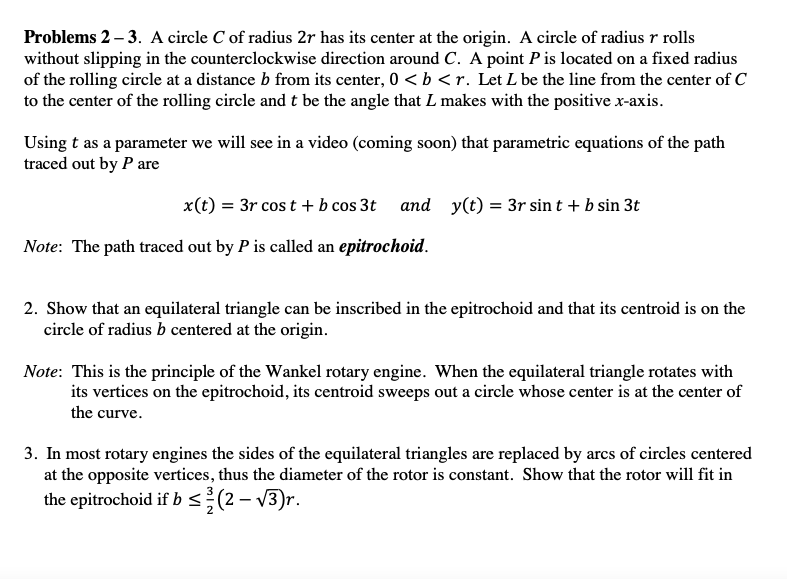2. Show that an equilateral triangle can be inscribed in the epitrochoid and that its centroid is on the circle of radius b centered at the origin.
2. Show that an equilateral triangle can be inscribed in the epitrochoid and that its centroid is on the circle of radius b centered at the origin.
Algebra: Structure And Method, Book 1
(REV)00th Edition
ISBN:9780395977224
Author:Richard G. Brown, Mary P. Dolciani, Robert H. Sorgenfrey, William L. Cole
Publisher:Richard G. Brown, Mary P. Dolciani, Robert H. Sorgenfrey, William L. Cole
Chapter4: Polynomials
Section4.9: Area Problems
Problem 10P
Related questions
Question
Just #2. Thank you.

Transcribed Image Text:Problems 2 – 3. A circle C of radius 2r has its center at the origin. A circle of radius r rolls
without slipping in the counterclockwise direction around C. A point P is located on a fixed radius
of the rolling circle at a distance b from its center, 0 < b <r. Let L be the line from the center of C
to the center of the rolling circle and t be the angle that L makes with the positive x-axis.
Using t as a parameter we will see in a video (coming soon) that parametric equations of the path
traced out by P are
x(t) = 3r cos t + b cos 3t and y(t) = 3r sin t + b sin 3t
Note: The path traced out by P is called an epitrochoid.
2. Show that an equilateral triangle can be inscribed in the epitrochoid and that its centroid is on the
circle of radius b centered at the origin.
Note: This is the principle of the Wankel rotary engine. When the equilateral triangle rotates with
its vertices on the epitrochoid, its centroid sweeps out a circle whose center is at the center of
the curve.
3. In most rotary engines the sides of the equilateral triangles are replaced by arcs of circles centered
at the opposite vertices, thus the diameter of the rotor is constant. Show that the rotor will fit in
the epitrochoid if b <(2 – V3)r.
Expert Solution
This question has been solved!
Explore an expertly crafted, step-by-step solution for a thorough understanding of key concepts.
This is a popular solution!
Trending now
This is a popular solution!
Step by step
Solved in 2 steps with 1 images

Recommended textbooks for you

Algebra: Structure And Method, Book 1
Algebra
ISBN:
9780395977224
Author:
Richard G. Brown, Mary P. Dolciani, Robert H. Sorgenfrey, William L. Cole
Publisher:
McDougal Littell

Mathematics For Machine Technology
Advanced Math
ISBN:
9781337798310
Author:
Peterson, John.
Publisher:
Cengage Learning,

Algebra and Trigonometry (MindTap Course List)
Algebra
ISBN:
9781305071742
Author:
James Stewart, Lothar Redlin, Saleem Watson
Publisher:
Cengage Learning

Algebra: Structure And Method, Book 1
Algebra
ISBN:
9780395977224
Author:
Richard G. Brown, Mary P. Dolciani, Robert H. Sorgenfrey, William L. Cole
Publisher:
McDougal Littell

Mathematics For Machine Technology
Advanced Math
ISBN:
9781337798310
Author:
Peterson, John.
Publisher:
Cengage Learning,

Algebra and Trigonometry (MindTap Course List)
Algebra
ISBN:
9781305071742
Author:
James Stewart, Lothar Redlin, Saleem Watson
Publisher:
Cengage Learning

Trigonometry (MindTap Course List)
Trigonometry
ISBN:
9781305652224
Author:
Charles P. McKeague, Mark D. Turner
Publisher:
Cengage Learning